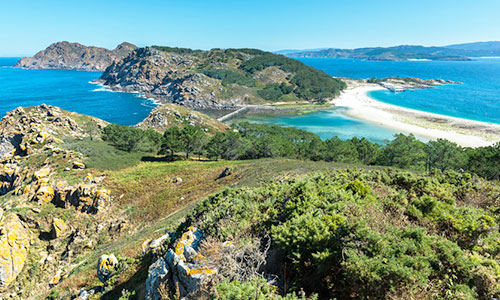
The Camino de Santiago–the Walk of Saint James–is the pilgrimage to Santiago de Compostela in honor of the titular saint. This UNESCO World Heritage Site is a very old pilgrimage from the 10th century and is one of three largest ones to exist. This has been attractive to thousands of people from varying backgrounds over the hundreds of years. This is an excellent opportunity to meet diverse travelers while practicing language skills! Along the way, you’ll see historic sites like St. Mary’s Cathedral (on French Way) and glorious landscapes that really enhance a lovely or even spiritual journey. Walking pilgrims (or bicigrinos–biking pilgrims) can appreciate the beautiful views, commune with nature, and search for religious epiphanies or peace, if they so choose.
Interestingly, there are multiple ways to arrive at the city proper. It all depends on where you decide to begin. Take a look at the map or visit this explanatory site to deliberate on which trailway would be best for you and your group. Depending on which one you choose, the terrain may be flat or rocky; the weather may be humid or brisk; the views may be mountainous or dispersed with fields. You also don’t have to complete the entire thing, as that would be incredibly difficult if you were leading a handful of students–many people complete the last handful of miles into Santiago de Compostela. (Although if you want to get the official certificate in Santiago, you have to complete 100 km of walking or 200 km of biking.) Just in case you lose your way, you must pack a map, but you can also download this app that has successfully led travelers through all of the different routes.
But why has it been so popular for so long? Even today, there has been a recent surge in pilgrims once again traveling the Camino. Félix Duque wrote a fascinating article on the anthropology and philosophy behind this pilgrimage phenomenon, particularly in regards to the Camino itself. It would be an interesting and enlightening assignment to ask yourself and your students why one might go on this pilgrimage, on a personal as well as a more broad level. What kind of philosophy are you applying to your journey? If something so beautiful exists, does it have a more sinister binary in its history in order to restore balance? How does myth and legend influence history? Walking this Camino would encourage a compelling discussion on how pilgrimages affect the human psyche. Here you can watch a wonderful documentary about a woman named Stephanie Hurtado and her own journey. (Quite helpfully, she lists exactly what she packed for her trip and the exact breakdown of her trip in kilometers.) She actually gets to “The End of the World” which is past the city and to the coastline where the view of the city is breathtaking. Finally, she says her goodbyes to the city and to her father who died not long after this hike. Everyone who goes on the Camino has their reasons for why, and her experience would be an excellent model to all would-be pilgrims. Are you ready to face your own why on the Camino de Santiago?
Works Cited:
“Camino de Santiago. All you need to know.” CaminoWays.com. https://caminoways.com/camino-de-santiago#:~:text=The%20Camino%20de%20Santiago%20routes%20are%20a%20network%20of%20many,for%20every%20interest%20and%20ability.
“Camino de Santiago Documentary | Walk Through Fire.” YouTube. uploaded by Stefanie Hurtado, May 19, 2023. https://www.youtube.com/watch?v=U2mrbhPhASA.
“Camino de Santiago Routes, how to Choose the BEST for you.” Marly Camino. 2017. https://marlycamino.com/right-camino-de-santiago-route/.
“Camino Routes.” Follow the Camino. https://followthecamino.com/en/camino-de-santiago-routes/.
Duque, Félix. “Via Stellarum—via Crucis: A Philosophical Approach to the ‘Camino de Santiago.’” Anthropology and Aesthetics, no. 63-64, 2013, pp. 267–78. http://www.jstor.org/stable/23647769.
